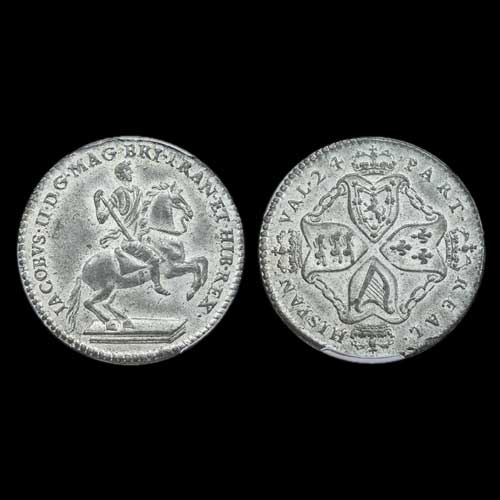1688 American Plantations Token Auctioned
2017-07-04 Tue
Original tokens issued under King James II of England were made in tin. In 1688, a franchise was granted to Richard Holt for producing these tokens. In 1828, restrikes were produced in pewter using the original 17th century dies. Many original tokens feature black oxidation.An MS 63, original tin token without the black oxidation, with a CAC sticker was sold for $9,987.50 by Heritage Auctions in June. Experts have identified seven different obverse, and seven different reverse dies. The token has a value of 1/24th of a Spanish real, the obverse features King James II riding a horse. Latin inscriptions include “IACOBVS . II . D G . MAG . BRI . FRAN . ET . HIB . REX” which means “James II by the grace of God King of Great Britain, France and Ireland”. The reverse features four crowned shields of England, Scotland, France and Ireland connected with chains along with the legend “VAL . 24 PART . REAL . HISPAN” which means “Value a 24th part of a Spanish real”. The token was equal to one and a half farthings from England.
Holt was a leader of many tin mine-owners and was given the right to produce American Plantations tokens. These tokens were made of 97.5 percent pure tin with an average weight of approximately 8.75 grams. It is not sure if these tokens were actually approved or even shipped to the colonies. Engraver John Roettier was given the responsibility to design and cut the American Plantations Token dies.
Many of the Roettier dies were acquired by a London coin dealer in 1828. Restrikes in a pewter alloy were made using two pairs and related tooling. Unused dies and tokens struck under Holt were sold to the British Museum.
Latest News
-
Ghiyath Shah as Sultan
2025-10-17 FriAfter ascending the throne of the Malwa Sultanate, Ghiyath Shah issued circular coins early in his r...
-
Malwa Sultan Ghiyath Shah Square Gold Tanka
2025-10-16 ThuMalwa Sultan Ghiyath Shah issued square gold tankas in three weight standards: Double Tanka (21.9g),...
-
Malwa Sultan Ghiyath Shah's Billon Tanka as Heir Apparent
2025-10-14 TueIn Billon, Ghiyath Shah issued coins under two weight standards. Billon Tanka of 96 rati (10.7-11g),...
-
Antiochos I Soter Silver Tetradrachm, weighing 16.87 grams, sold for INR 22,000.
2025-10-07 TueAntiochos I, the Greek king of the Seleucid Empire, was of mixed heritage, being half-Iranian and ha...
-
Ghiyath Shah as Heir Apparent
2025-09-25 ThuGhiyath Shah was the ruler of the Malwa Sultanate, reigning from 1456 to 1500. From 1456 to 1469, he...

